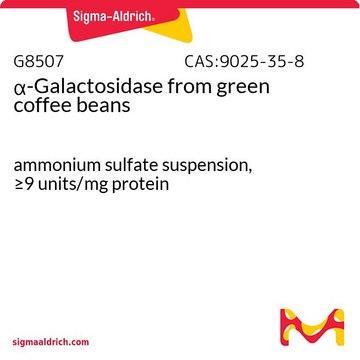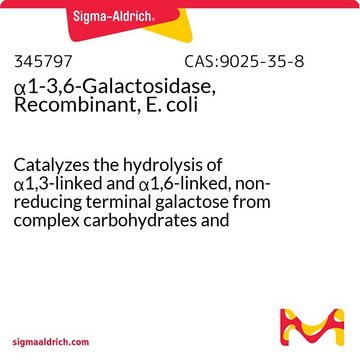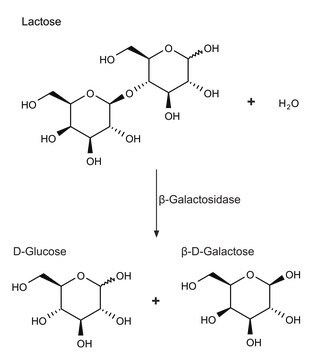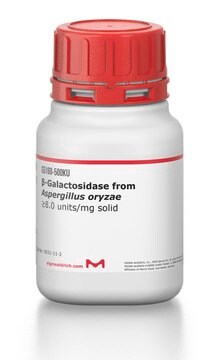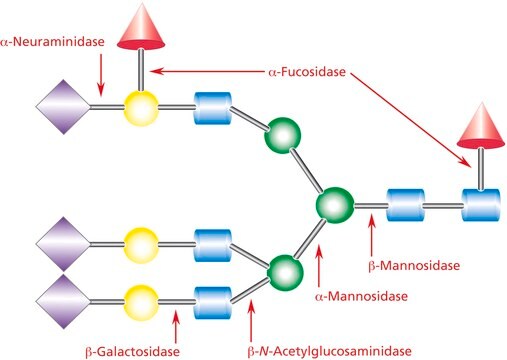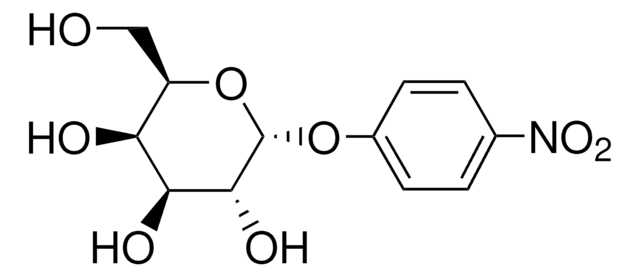G7163
α-Galactosidase, positionally specific from Escherichia coli
recombinant, expressed in E. coli, buffered aqueous solution
Synonym(s):
1,6-alpha-D-galactoside galactohydrolase, alpha-Galactosidase, melibiase
Sign Into View Organizational & Contract Pricing
All Photos(1)
About This Item
CAS Number:
MDL number:
UNSPSC Code:
12352204
NACRES:
NA.32
Recommended Products
recombinant
expressed in E. coli
Quality Level
form
buffered aqueous solution
specific activity
≥20 units/mg protein
mol wt
80 kDa
shipped in
wet ice
storage temp.
2-8°C
Gene Information
Escherichia coli CFT073 ... melA(1037886)
Related Categories
Biochem/physiol Actions
Cleaves α(1→3)- and α(1→6)-linked, non-reducing terminal galactose from complex carbohydrates and glycoproteins. It is particularly efficient for removing α-linked galactose under conditions where the pH must be neutral or above, for example, with live cells.
Unit Definition
One unit will hydrolyze 1 μmole of p-nitrophenyl α-D-galactopyranoside per min at pH 6.5 at 25 °C.
Physical form
This product is a sterile-filtered aqueous buffered solution.
inhibitor
Product No.
Description
Pricing
substrate
Storage Class Code
12 - Non Combustible Liquids
WGK
WGK 2
Flash Point(F)
Not applicable
Flash Point(C)
Not applicable
Certificates of Analysis (COA)
Search for Certificates of Analysis (COA) by entering the products Lot/Batch Number. Lot and Batch Numbers can be found on a product’s label following the words ‘Lot’ or ‘Batch’.
Already Own This Product?
Find documentation for the products that you have recently purchased in the Document Library.
Customers Also Viewed
K Schmid et al.
European journal of biochemistry, 67(1), 95-104 (1976-08-01)
The utilization by Escherichia coli K12 of raffinose as sole carbon source depends on a new raffinose transport system, an invertase and an alpha-galactosidase specified by the Raf-plasmid D1021. The alpha-galactosidase was purified to homogeneity from a mutant strain with
Romain Merceron et al.
The Journal of biological chemistry, 287(47), 39642-39652 (2012-09-27)
The α-galactosidase AgaA from the thermophilic microorganism Geobacillus stearothermophilus has great industrial potential because it is fully active at 338 K against raffinose and can increase the yield of manufactured sucrose. AgaB has lower affinity for its natural substrates but
Hongwei Gao et al.
Artificial cells, nanomedicine, and biotechnology, 41(1), 32-36 (2012-10-04)
Enzymatical conversion of A or B RBCs into group O RBCs (ECORBCs) was achieved by using α-N-acetylgalactosaminidase and α-galactosidase, respectively. Now, we initiated AB to O-RBC conversion by using these two enzymes together. But α-N-acetylgalactosaminidase and α-galactosidase's preserving and their
Dominique P Germain et al.
Orphanet journal of rare diseases, 7, 91-91 (2012-11-28)
Fabry disease (FD) is a genetic disorder resulting from deficiency of the lysosomal enzyme α-galactosidase A (α-Gal A), which leads to globotriaosylceramide (GL-3) accumulation in multiple tissues. We report on the safety and pharmacodynamics of migalastat hydrochloride, an investigational pharmacological
Costanza Simoncini et al.
The neurologist, 18(6), 413-414 (2012-11-02)
Fabry disease (FD) is a rare, X-linked lysosomal storage disorder with multiorgan involvement. FD is caused by a partial or total deficit of α-galactosidase A enzyme, which is responsible for the accumulation of glycosphingolipids in a variety of cell types.
Our team of scientists has experience in all areas of research including Life Science, Material Science, Chemical Synthesis, Chromatography, Analytical and many others.
Contact Technical Service